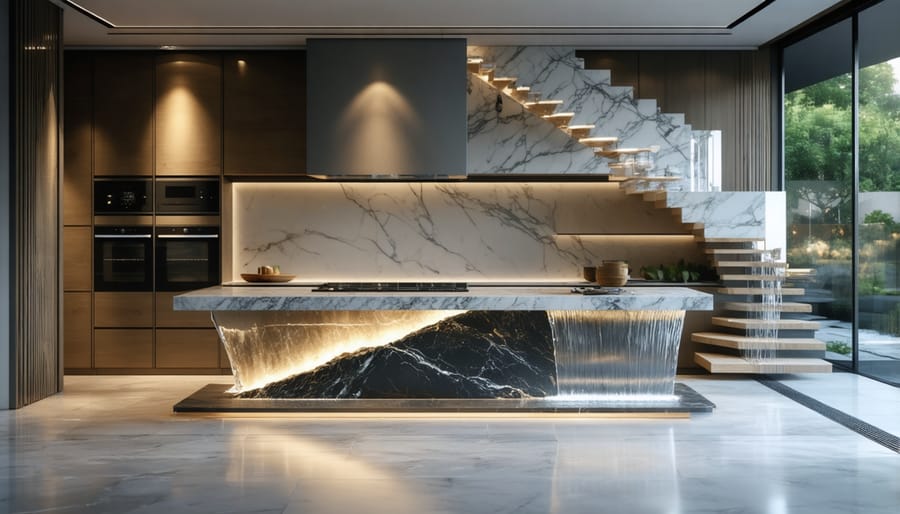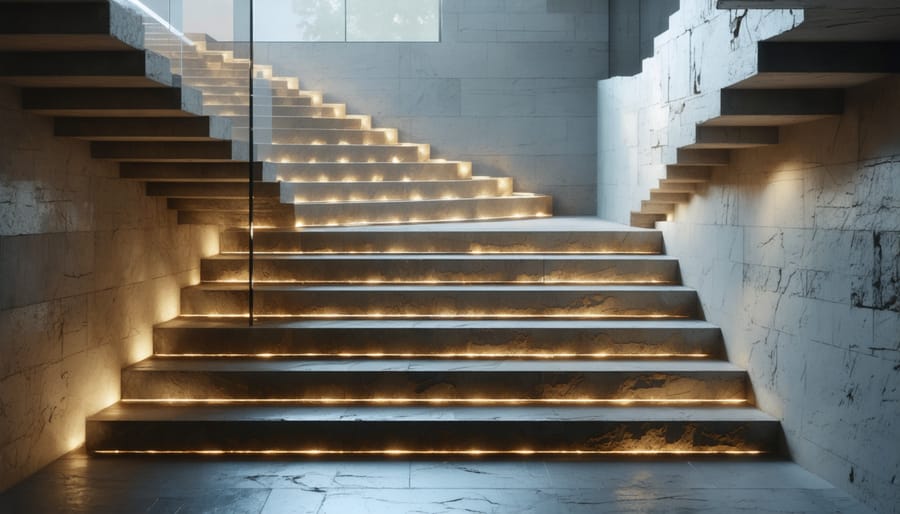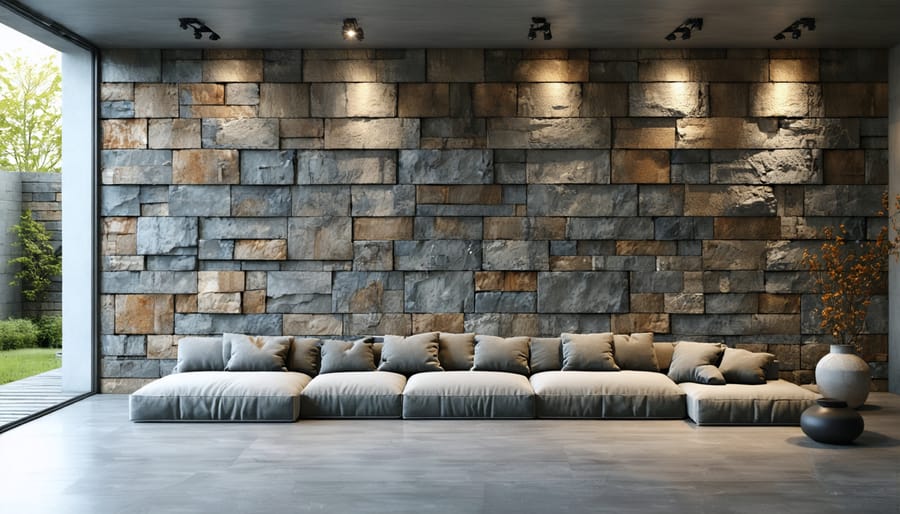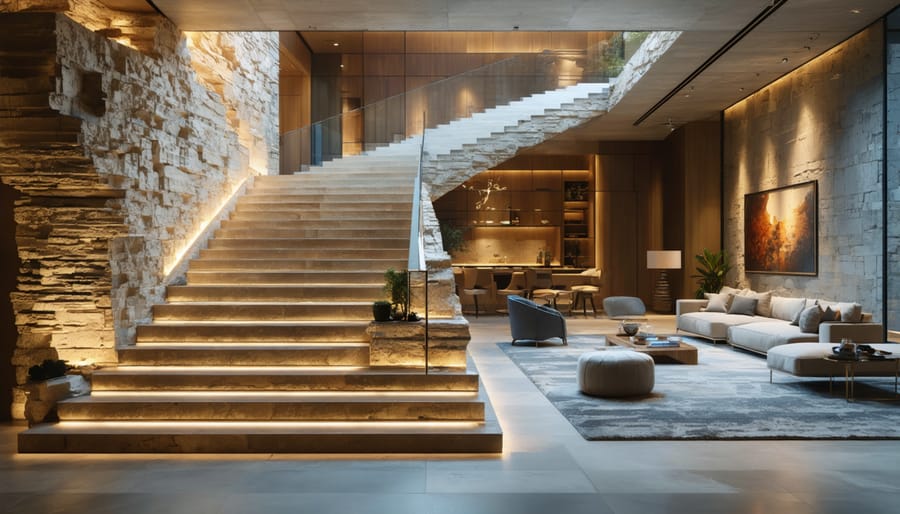Natural stone transcends its traditional role as mere building material, emerging as a boundless canvas for architectural innovation and artistic expression. From sculpted limestone waterfalls to backlit onyx feature walls, creative natural stone selection opens unprecedented possibilities in modern design. Today’s cutting-edge fabrication technologies transform raw stone into fluid, organic forms that challenge our perception of this ancient material.
Master craftsmen now bend, illuminate, and texture stone in ways previously unimaginable, creating installations that blur the line between functional architecture and fine art. Whether floating seamlessly across walls, forming sculptural staircases, or appearing to defy gravity in cantilever applications, innovative stone design reshapes both residential and commercial spaces with distinctive character.
This revolution in stone craftsmanship combines age-old materials with contemporary engineering, delivering solutions that are simultaneously timeless and forward-thinking. The result? Spaces that capture nature’s raw beauty while pushing the boundaries of what’s possible in modern architecture and interior design.
Innovative Natural Stone Design Concepts
Mixed Material Integration
The art of combining natural stone with complementary materials creates striking visual contrasts and dynamic design elements that elevate any space. Wood brings organic warmth when paired with stone, creating a harmonious balance between rustic and refined. Consider a limestone feature wall accented by rich walnut shelving, or a granite kitchen island topped with a butcher block preparation area.
Metal elements introduce industrial sophistication when integrated with stone surfaces. Brushed brass or copper inlays in marble flooring create elegant geometric patterns, while stainless steel trim can frame slate wall panels for a contemporary edge. These metallic accents catch light and add dimensional interest to stone installations.
Glass introduces transparency and lightness to stone’s solidity, offering fascinating textural interplay. Glass partitions alongside travertine walls allow natural light to flow while maintaining visual connection between spaces. Backlit onyx panels paired with frosted glass create ethereal lighting effects perfect for feature walls or bar areas.
For maximum impact, consider combining all three materials with stone as the foundation. A modern fireplace surround might incorporate rough-cut granite with a floating wooden mantel, metal accent strips, and glass panels. In bathrooms, marble vanities can be elevated with wood cabinetry, chrome fixtures, and glass shower enclosures, demonstrating how thoughtful material integration enhances both functionality and aesthetic appeal.

Textural Contrasts
Natural stone’s versatility shines through its diverse textural possibilities, offering designers and homeowners endless opportunities for creative expression. By combining different finishes within a single space, you can create dramatic visual contrasts that elevate your design from ordinary to extraordinary. Popular finish combinations include honed and polished surfaces, which play with light reflection to add depth and sophistication to stone facade designs and interior features.
Consider pairing smooth, polished marble countertops with a split-face limestone backsplash, or contrast rough-hewn granite wall panels with sleek, flame-finished flooring. The interplay between rough and smooth textures creates a dynamic visual experience while highlighting the natural characteristics of each stone type.
Popular textural finishes include:
– Polished: Glossy, mirror-like finish
– Honed: Smooth but matte appearance
– Flamed: Rough, non-slip surface
– Bush-hammered: Textured, weathered look
– Split-face: Natural, rustic finish
The key to successful textural contrast lies in thoughtful placement and balanced distribution. Too many competing textures can overwhelm a space, while strategic combinations create focal points and define distinct zones within a room. When selecting finishes, consider both aesthetic appeal and practical requirements, such as slip resistance for flooring or ease of maintenance for kitchen surfaces.
Unexpected Stone Applications
Floating Stone Features
Floating stone features create dramatic visual impact by appearing to defy gravity, adding an element of architectural wonder to any space. Through innovative engineering and careful structural support, natural stone can be suspended or cantilevered to create striking design elements. Common applications include floating stone staircases, suspended countertops, and hovering garden benches that seem to emerge directly from walls.
The key to successful floating stone features lies in hidden support systems, typically comprising steel reinforcement bars, brackets, or tension cables. Modern adhesives and mounting techniques allow for minimal visible hardware while ensuring structural integrity. Popular choices for these applications include granite and engineered quartz due to their strength and durability.
When designing floating stone elements, consider the stone’s weight-bearing capacity and the supporting structure’s limitations. Proper installation by experienced professionals is crucial, as these features require precise calculations and specialized mounting techniques. The visual lightness of floating stone creates striking contrasts with solid walls and can make spaces appear larger and more dynamic.

Interior Accent Walls
Natural stone interior accent walls can transform ordinary rooms into extraordinary spaces with their dramatic visual impact. By incorporating materials like slate, quartzite, or marble on a single feature wall, you create an instant focal point that draws the eye and adds architectural interest. Popular locations for stone accents include living room fireplaces, master bedroom headboard walls, and entrance foyers.
The key to successful accent walls lies in selecting stones that complement your existing décor while making a bold statement. Consider using horizontally stacked ledger stone for a contemporary look, or opt for large-format marble slabs to achieve modern elegance. Textured limestone panels can add warmth and dimension to minimal spaces, while mosaic patterns crafted from mixed stone varieties create artistic focal points.
Lighting plays a crucial role in maximizing the impact of stone accent walls. Strategic placement of uplighting or downlighting can emphasize the natural textures and variations in the stone, creating dramatic shadows that change throughout the day. This interplay of light and texture brings the organic beauty of natural stone to life within interior spaces.
Sustainable Stone Design Solutions
Reclaimed Stone Integration
Reclaimed stone materials offer a sustainable and character-rich option for modern design projects. These salvaged materials, often sourced from historic buildings, old farmhouses, and demolished structures, bring unique patinas and weathered textures that new stone simply cannot replicate. When integrated thoughtfully, reclaimed stone creates a compelling narrative that bridges past and present architectural styles.
Designers are increasingly incorporating these materials through feature walls, fireplace surrounds, and outdoor hardscaping elements. The key to successful integration lies in balancing the aged appearance of reclaimed stone with contemporary design elements. For example, pairing weathered limestone with sleek glass and steel creates striking visual contrasts that highlight both materials’ qualities.
Practical considerations include carefully documenting the origin and characteristics of salvaged stone, ensuring structural integrity, and working with experienced masons who understand the unique challenges of reclaimed materials. While initial sourcing may require more effort than purchasing new stone, the environmental benefits and distinctive aesthetic appeal make reclaimed stone integration an increasingly popular choice for sustainable design projects.

Local Stone Sourcing
Using locally sourced stone materials offers numerous advantages for both sustainability and design authenticity. Regional stone varieties naturally complement the local landscape and architecture, creating a seamless connection between built structures and their environment. These materials often come with lower transportation costs and reduced carbon footprint, making them an environmentally conscious choice.
Local stones bring unique characteristics shaped by regional geology, from the warm honey-colored limestone of the Southwest to the rugged granite of New England. These distinctive qualities allow designers to create projects that truly reflect the area’s natural heritage. Working with local quarries also supports regional economies and ensures a reliable supply chain for ongoing and future projects.
Additionally, local stone varieties are typically well-suited to the area’s climate conditions, having naturally weathered similar environmental challenges for centuries. This inherent durability translates to better long-term performance and reduced maintenance requirements, making them a practical choice for both interior and exterior applications.
Natural stone continues to redefine modern architecture and interior design, pushing boundaries beyond traditional applications. As we’ve explored throughout this article, creative stone implementations have transformed from simple decorative elements into sophisticated design statements that can dramatically increase your home’s value while delivering unmatched aesthetic appeal.
Looking ahead, industry trends suggest an increasing fusion between natural stone and sustainable design practices. Innovative fabrication technologies are making it possible to use stone more efficiently, reducing waste while enabling more intricate patterns and applications. We’re seeing a growing preference for locally sourced materials, textured finishes, and mixed-material designs that combine stone with wood, metal, and glass.
The future of creative stone applications lies in smart integration with modern technology, including LED-embedded stone features and thermally efficient applications. Designers are increasingly experimenting with thin stone veneers, allowing for lighter installations and more versatile applications in both interior and exterior spaces.
As environmental consciousness grows, we can expect to see more emphasis on sustainable quarrying practices and the use of reclaimed stone materials. The timeless appeal of natural stone, combined with advancing technology and creative design approaches, ensures its continued prominence in architectural and design innovations for years to come.










